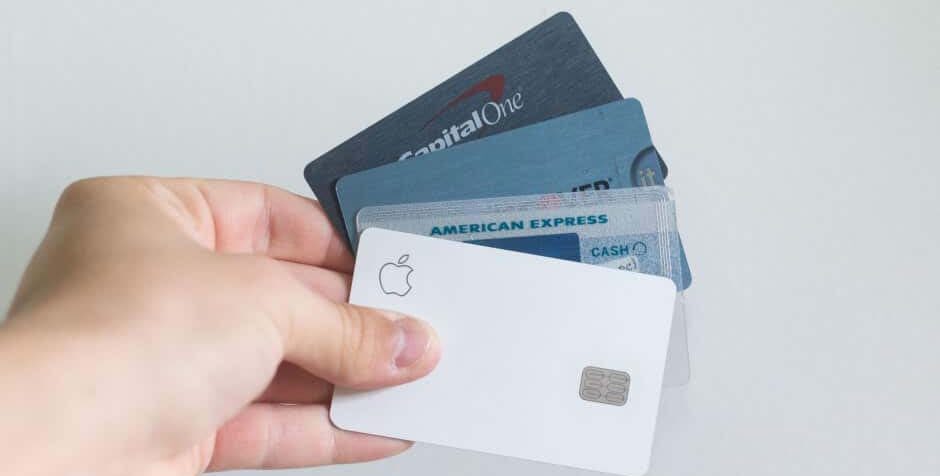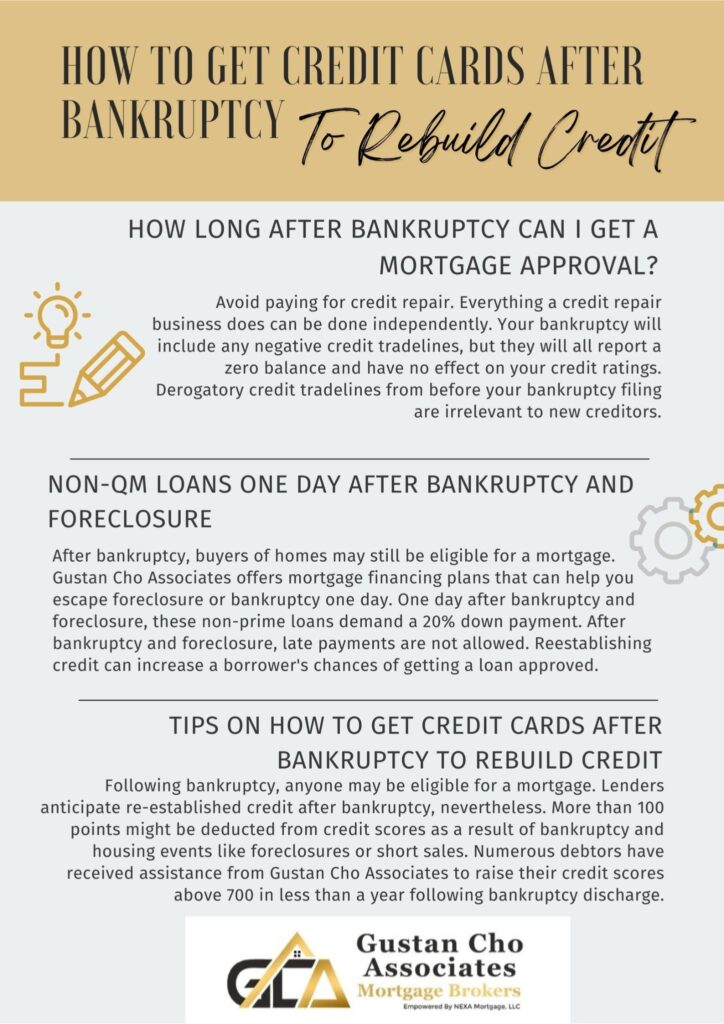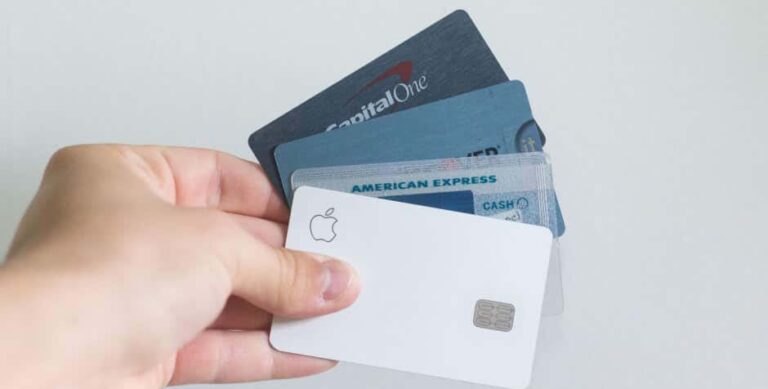How To Get Credit Cards After Bankruptcy To Rebuild Credit
This article will discuss how to get credit cards after bankruptcy to rebuild credit to qualify for a mortgage. How can you quickly re-establish credit following bankruptcy? One of the easiest and quickest ways to re-establishing credit after bankruptcy is getting three to five secured credit cards or a “second chance” credit card. Take out a small personal loan.
Charge small amounts and pay your bills on time every month. Ask a friend or relative with good credit to add you as an authorized user to one or more accounts.
It takes time and effort to re-establish credit after bankruptcy so that you can buy a home. You can use the mandatory waiting periods most mainstream lenders require to improve your credit history and scores. In the following sections of this guide, we will cover how to get credit cards after bankruptcy to rebuild credit to get a mortgage loan approval.
How Long After Bankruptcy Can I Get a Mortgage Approval?
Do not spend money on credit repair. Whatever a credit repair company can be done by itself. Derogatory credit tradelines included in your bankruptcy will all report a zero balance and has no impact on your credit scores. New creditors do not care about derogatory credit tradelines before your bankruptcy filing.
If you find the process challenging or need personalized advice, consider consulting with a financial advisor. They can provide guidance based on your specific financial situation. Re-establishing credit with secured credit cards can be a strategic step toward improving your credit score and eventually qualifying for a mortgage. In the following paragraphs, we will discuss a step-by-step guide on how to get credit cards after bankruptcy to qualify for a mortgage.
Prequalify for a bankruptcy mortgage in about five minutes.
Understand Your Current Credit Situation
Obtain a copy of your credit report to understand your current credit status. You are entitled to one free credit report annually from each of the major credit bureaus (Equifax, Experian, and TransUnion). Determine the credit score you need to qualify for a mortgage. Most conventional mortgages require a minimum credit score, so set a realistic goal based on your current score.
Apply for a Secured Credit Card
Research and apply for a secured credit card. Secured credit cards require a security deposit, which usually becomes your credit limit. This minimizes the risk for the card issuer, making it easier for individuals with poor credit to be approved. Once approved, use the secured card responsibly. Make small purchases and ensure that you can pay the balance in full each month. This demonstrates responsible credit behavior to creditors.
Pay On Time
Timely payments are crucial for rebuilding credit. Set up reminders or automatic payments to ensure you never miss a due date. Payment history is a significant factor in your credit score. Aim to keep your credit card balances low relative to your credit limit. This demonstrates responsible credit utilization, which is another factor that affects your credit score.
Monitor Your Credit Score
Regularly monitor your credit score to track your progress. You can use free services or subscribe to credit monitoring services to keep an eye on any changes. Some secured credit card issuers offer the possibility of upgrading to an unsecured card after demonstrating responsible credit behavior. This typically involves a review of your payment history and overall financial situation.
Diversify Your Credit
While working on your credit cards, consider other forms of credit, such as installment loans. A diverse credit mix can positively impact your credit score. Rebuilding credit takes time. Be patient and persistent in your efforts. Consistent, responsible financial behavior will gradually improve your creditworthiness. Remember, the goal is to demonstrate responsible credit management over time. As your credit score improves, you’ll be in a better position to qualify for a mortgage with more favorable terms.
Non-QM Loans One Day After Bankruptcy and Foreclosure
Homebuyers can qualify for a mortgage after bankruptcy. Gustan Cho Associates has mortgage loan programs that can finance you one day out of bankruptcy or foreclosure. These non-prime (aka non-QM) loans one day after bankruptcy and foreclosure require a 20% down payment. You can’t have any late payments after bankruptcy and foreclosure. Borrowers need to re-establishing credit can improve their chances of loan approval.
Qualify For Non-Qm After Bankruptcy, Click Here
Tips on How To Get Credit Cards After Bankruptcy To Rebuild Credit
The team at Gustan Cho Associates has helped thousands of homebuyers how get credit cards after bankruptcy to rebuild credit to qualify for a mortgage. Everyone can qualify for a mortgage after bankruptcy. However, lenders expect to see re-established credit after bankruptcy.
Gustan Cho Associates gets countless calls about mortgages after bankruptcy. Bankruptcy and housing events like foreclosures or short sales.
A bankruptcy or a housing event can drop credit scores by more than 100 points. However, the great news is the drop is temporary. As the bankruptcy and housing event ages, credit scores will naturally increase. That is if you re-establish credit. Gustan Cho Associates has helped countless borrowers get credit scores over 700 in less than one year after bankruptcy discharge.
Secured Credit Cards Help Re-Establish Credit After Bankruptcy
Credit cards are the fastest tools and easiest to re-establish credit and boost credit scores after bankruptcy and housing event. Many consumers are often confused about how to get credit cards to re-establish and increase credit scores after bankruptcy and a housing event if their scores just tanked.
We will explain how to re-establish and increase credit scores after bankruptcy and foreclosure with secured credit cards.
The easiest and fastest way to rebuild credit after bankruptcy and foreclosure is to get three to five secured credit cards. The fastest and best way how to get credit cards after bankruptcy to rebuild credit is getting three to five secured credit cards with at least a $500 credit limit.
How To Get Secured Credit Cards After Bankruptcy
Many who file bankruptcy often swear they will never obtain credit again after their bankruptcy discharge. Unfortunately, not having established credit hurt consumers. Do not go crazy applying for unsecured credit cards and other forms of credit after your bankruptcy discharge. You will not get approved for unsecured credit right after a recent discharge. The sooner you get new credit after a bankruptcy discharge, the sooner you will go on the road to re-establishing your credit and maximizing your credit scores.
How To Get Secured Credit Cards After Bankruptcy With Low Credit Scores
One way how to get credit cards after bankruptcy is with secured credit cards. Secured credit cards require you to leave an amount on deposit with the card issuer. That deposit is usually your credit limit. Only apply for cards from companies that report your payment history to the three big credit bureaus — Experian, TransUnion, and Equifax. Not all secured credit cards report to all three credit bureaus.
When getting credit cards, please read the fine print because these cards can have some nasty fees buried there.
There are fees on secured credit cards that can include activation charges, set-up fees, maintenance charges, and more. Compare several and pick one with low out-of-pocket costs. Once you have a good payment history with a secured card, apply for one or more regular credit cards.
Using Installment Loans To Rebuild Credit After Bankruptcy
Installment loans give you a lump sum, and you pay it back monthly. Your interest rate is usually fixed. Once you have re-establish good credit, apply for a small personal loan. The interest rate will likely be pretty high.
Contact the secured card issuer — some secured cards convert to regular cards after you make on-time payments for a few months if you ask. And you get your deposit back.
Installment accounts carry more weight with credit bureaus, and paying one-off can impact your credit score more than paying a credit card account. In addition, adding an installment loan improves your mix of credit types (10 percent of your FICO score). For fair credit loans from peer-to-peer sites, installment loan rates can range from 0% to 36% or higher.
How To Get Credit Cards After Bankruptcy By Adding Yourself As an Authorized User
Another way to get good credit history is to become an authorized user on someone else’s account. The account history attaches to your credit report and helps you rebuild your score.
Ensure that the account holder has good credit and makes the payment on time (within 30 days of the due date).
If he or she pays late, that shows up on your credit report and hurts your score. Don’t abuse the accountholder’s trust. Do not use the account. It’s probably better if you don’t even know the account number.
Qualify For Mortgage After Bankruptcy, Click Here
How Long Does It Take To Re-establish Credit After Bankruptcy?
It takes at least six to 12 months to re-establish credit after bankruptcy. Creditors and lenders will also look at the length of your credit. As your new credit age, the stronger your credit profile will be. Secured credit cards are the best tool to re-establish credit after bankruptcy.
The credit card company gives you a credit limit increase without asking for an additional deposit with a good payment history. Be religious in making your minimum payments on time.
The ideal amount of secured credit cards you should get is three. Three secured credit cards with at least a $500 credit limit will do wonders and will be your road to a strong credit profile and high credit scores. It is not impossible to get your credit scores over 700 FICO after six to 12 months after a bankruptcy discharge.
Get a custom mortgage quote now.
Secured Credit Cards To Rebuild Credit After Bankruptcy and Foreclosure
Secured credit cards are VISA, Master Card, and Discover cards that work just like unsecured cards. However, the credit card company will request a deposit that is equivalent to the credit card limit. If you deposit $500 with the credit card company, they will issue a credit card with a $500 limit.
The secured credit card company will report your payment history to the credit bureaus. Minimum payment will be due every month.
Secured credit cards act the same way as unsecured cards. On-time and late payments report on all three credit bureaus. As your secured card ages, you will be developing a strong credit profile and history with both the credit bureaus and the creditor.
How Creditors and Lenders View Consumers with a Prior Bankruptcy
Lenders and creditors realize consumers who filed bankruptcy cannot file another bankruptcy until 8 years have passed. As long as consumers have proven themselves through re-established credit, creditors are willing to approve them for unsecured credit, auto loans, or mortgages.
If your bankruptcy is fresh, there is no bearing on the interest rates. Bankruptcy has no more impact on the interest rate.
With mortgages, a prior bankruptcy and/or foreclosure on government and conventional loans do not have an impact on mortgage rates. Bankruptcy rates have hit historic highs after the 2008 financial crisis. Economists expect bankruptcy rates to soar again due to the coronavirus pandemic economic crisis.
Bankruptcy due to Economic Hardship
Many who fell victim to the 2008 financial crisis filed for bankruptcy, re-established credit, got stable jobs with a steady income, and were able to purchase a home and obtain a mortgage. The 2020 coronavirus economic meltdown may be worse than the 2008 economic crash.
Analysts and economists expect bankruptcies and foreclosure to soar in the coming months due to high inflation, soaring rates, and low housing inventory.
Bankruptcy is an option for consumers hurting financially and unemployed. Remember that there is life after bankruptcy. Secured credit cards are the easiest and fastest way of rebuilding credit and higher credit scores after bankruptcy.
Click Here To Get Mortgage Loans
How to Qualify for Mortgage after Bankruptcy
There are mortgage programs where there is no waiting period after the bankruptcy discharged date. FHA and VA have a two-year waiting period after Chapter 7 Bankruptcy discharge. USDA requires a three-year waiting period after Chapter 7 Bankruptcy. VA and FHA allow borrowers to qualify for FHA or VA loans during Chapter 13 Bankruptcy repayment plan with trustee approval. However, the borrower needs to be in Chapter 13 Bankruptcy repayment plan for at least 12 months with timely payments.
There is no waiting period after the Chapter 13 Bankruptcy discharged date to qualify for FHA and VA loans.
Fannie Mae and Freddie Mac have a four-year waiting period after the Chapter 7 Bankruptcy discharged date. The waiting period is two years after the Chapter 13 discharged date. The waiting period is 4-years after the Chapter 13 Bankruptcy dismissal date. Never be late on any monthly payments after bankruptcy. Lenders and creditors frown on borrowers who had late payments after bankruptcy. They often refer borrowers with late payments after bankruptcy as second offenders and want nothing to do with them.
Non-QM Mortgages One Day Out of Bankruptcy and Foreclosure
Some folks recover sooner than others after bankruptcy. This is the reason why Gustan Cho Associates offer non-QM mortgages one day out of bankruptcy and foreclosure.
Gustan Cho Associates has helped borrowers with late payments after bankruptcy. However, it is not easy approving anyone with late payments after bankruptcy.
The lower the credit of the borrower, the higher the risk for lenders. Non-QM loans one day out of bankruptcy and foreclosure requires a 30% down payment. The longer the bankruptcy has aged, the lower the down payment









